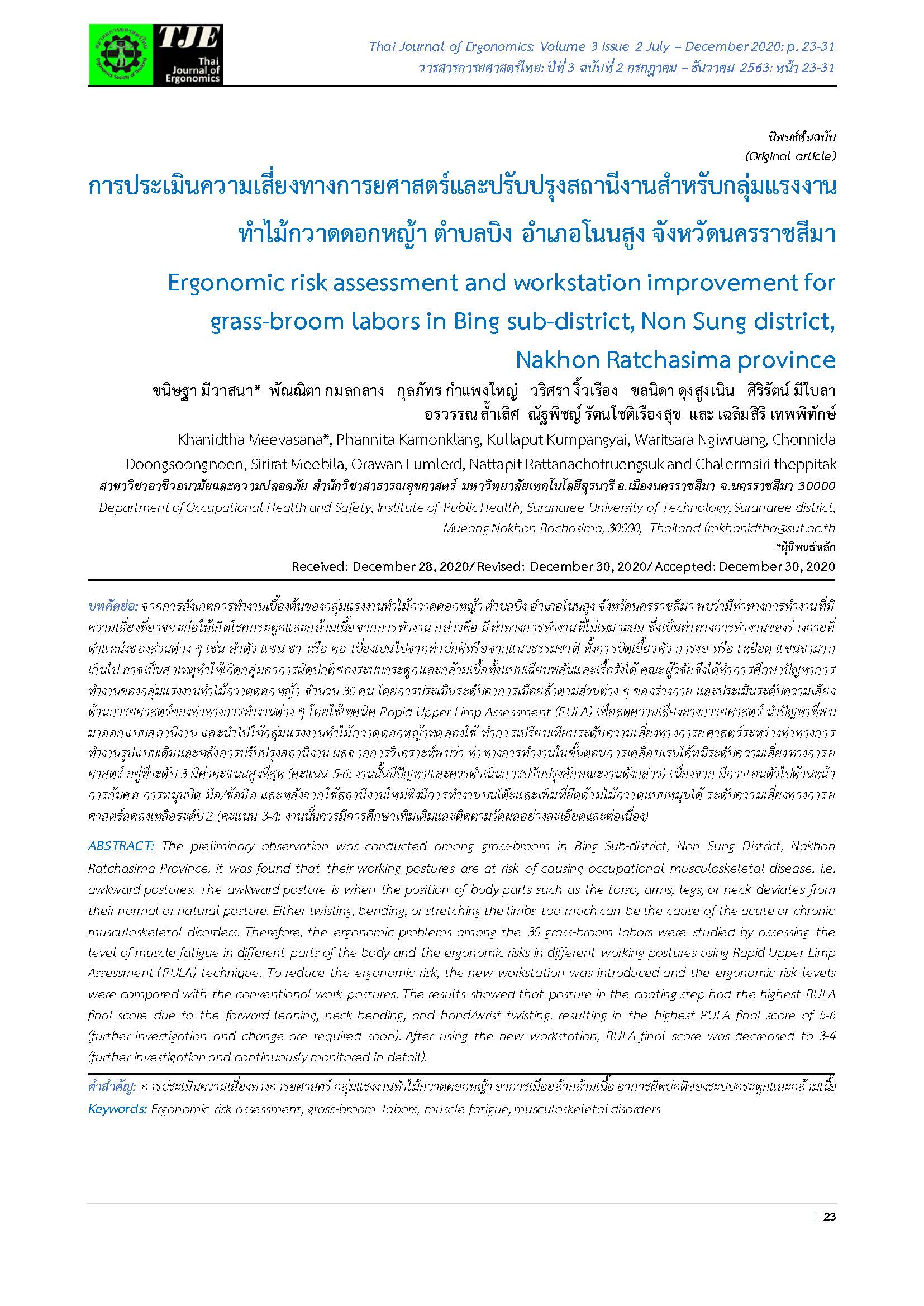Ergonomic risk assessment and workstation improvement for grass-broom labors in Bing sub-district, Non Sung district, Nakhon Ratchasima province
Main Article Content
Abstract
The preliminary observation was conducted among grass-broom in Bing Sub-district, Non Sung District, Nakhon Ratchasima Province. It was found that their working postures are at risk of causing occupational musculoskeletal disease, i.e.
awkward postures. The awkward posture is when the position of body parts such as the torso, arms, legs, or neck deviates from their normal or natural posture. Either twisting, bending, or stretching the limbs too much can be the cause of the acute or chronic musculoskeletal disorders. Therefore, the ergonomic problems among the 30 grass-broom labors were studied by assessing the level of muscle fatigue in different parts of the body and the ergonomic risks in different working postures using Rapid Upper Limp Assessment (RULA) technique. To reduce the ergonomic risk, the new workstation was introduced and the ergonomic risk levels
were compared with the conventional work postures. The results showed that posture in the coating step had the highest RULAfinal score due to the forward leaning, neck bending, and hand/wrist twisting, resulting in the highest RULA final score of 5-6 (further investigation and change are required soon). After using the new workstation, RULA final score was decreased to 3-4 (further investigation and continuously monitored in detail).
Article Details

This work is licensed under a Creative Commons Attribution-NonCommercial-NoDerivatives 4.0 International License.
References
รัชฎาพร เกตานนท์ แนวแห่งธรรม. แนวทางการพัฒนาผลิตภัณฑภ์ ูมิปัญญาท้องถิ่นเพื่อสง่ เสริมเศรษฐกิจ
สร้างสรรค์ในจังหวัดนครปฐม. Veridian. 2560; 10(1): 994-1012.
ธัญชนก ชัยสุข, เดวิด ภิระบรรณ, แจ่มจิตร ภิระบรรณม และสุลีมาศ คำมุง. การจัดการวิสาหกิจชุมชนกลุ่ม
อาชีพไม้กวาดลายดอกแกว้ ตำบลดงสวุ รรณ อำเภอดอกคำใต ้ จังหวัดพะเยา. วารสารวิชาการสถาบันวิทยาการ
จัดการแห่งแปซิฟิค. 2559;2(2):73-96.
กองโรคจากการประกอบอาชีพและสิ่งแวดล้อม กรมควบคุมโรค กระทรวงสาธารณสุข. รายงานสถานการณ์
โรคและภัยสุขภาพจากการประกอบอาชีพและสิ่งแวดลอ้ ม ปี 2561. นนทบุรี: กรมควบคุมโรค; 2562.
Bernard BP. Musculoskeletal Disorders and Workplace Factors: A Critical Review of
Epidemiologic Evidence for Work-Related Musculoskeletal Disorders of the Neck, Upper
Extremity, and Low Back. U.S. Department of Health and Human Services, Cincinnati; 1997.
Hales TR, Bernard BP. Epidemiology of work-related musculoskeletal disorders. Orthop Clin
North Am. 1996;27(4):679-709.
Corlett EN, Bishop RP. A technique for measuring postural discomfort. Ergonomics, 1976;
:175-82.
McAtamney L, Corlett EN. RULA: A survey method for the investigation of work-related upper limb disorder. Appl Ergon. 1993; 24(3):91-9.
Promsri A. Assessment of working posture and work-related musculoskeletal disorders in Dok Kaew broom weaving workers. J Assoc Med Sci. 2017;50(1); 138-47.
Somayeh RM, Narges K. Evaluating Risk Factors of Work-Related Musculoskeletal Disorders in Assembly workers of Nishabur; Iran Using Rapid Upper Limb Assessment. J Health Dev.
;1(3):227-36.
Vathna M, Abdullah NS, Dawal SZM, Aoyama H, Sothea K, Investigation on musculoskeleton symptoms and ergonomic risk factors at metal stamping industry. Adv Eng Forum. 2013; 10:293-9.
Chowdury M. L. Rahman. Study and analysis of work postures of workers working in a ceramic industry through rapid upper limb assessment (RULA). Int J Eng Appl Sci. 2014;5(3):14-20.
Gholami A, Soltanzadeh A, Abedini R, Sahranavard M. Ergonomic assessment of
musculoskeletal disorders risk by rapid upper limb assessment (RULA) technique in a
porcelain manufacturing factory. J Res Health. 2014;4(1):608-12
Nishanth R, Muthukumar MV, Arivanantham A. Ergonomic Workplace Evaluation for Assessing Occupational Risks in Multistage Pump Assembly. Int J Comp Appl. 201;113(9):9-13.
กัลยรัตน์ วชิรสิริ และ สสิธร เทพตระการพร. การปรับปรุงงานเพื่อลดความเมื่อยล้าและความเสยี่ งจากท่าทางการทำงาน: กรณีศึกษาพนักงานในกระบวนการประกอบข้อต่อ. วารสารการยศาสตร์ไทย. 2560; 1(1):1-7.


